The Standard Closet Depth Per Location & Purpose
Author: Rick Worst | Editor: Omar Alonso
Review & Research: Jen Worst & Chris Miller
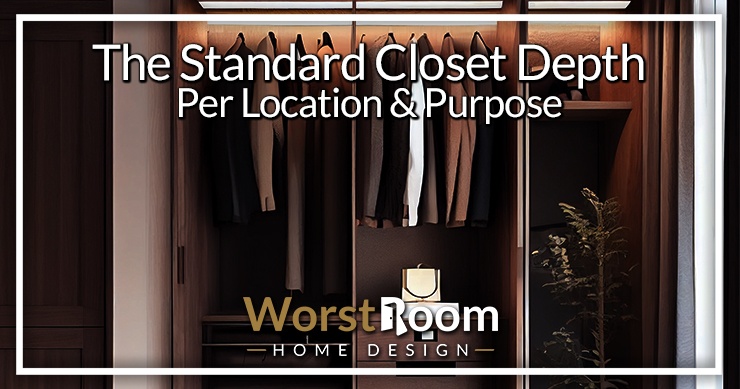
The standard closet depth is an essential factor to consider when designing and building a new closet space. It determines what type of shelving and hangers you can use in the closet. For example, you may want a closet that will give you enough room to store folded garments such as sweaters or jeans.
The standard closet depth is 24 inches but can vary depending on the type of closet you are building. Whether you are using wire shelving, wood shelves, hanging rods, or other closet organization systems, you will need to measure the depth of your closet and ensure it accommodates your items.
The article elaborates on the standard and average depth of a closet and how you can use it to create an efficient and organized space.
Most Reach-In Closets are About 24 Inches in Depth
How deep is a standard closet? The depth most people go for a closet or reach-in closet is 24 inches. The dimension allows plenty of room for you to hang shirts, suits, long dresses, and folded clothes. It will accommodate the width of nearly every hanger you may encounter, which range from the typical 17 to 18 inches for adult clothes up to 19 inches wide for large jackets.
When you have a standard reach-in closet, you can customize it to reap the benefits. Some of the benefits include the following:
- You can optimize the use of space inside the closet.
- You can better determine what type of shelves or hangers you need to buy.
- You can design the closet to make organizing and accessing items more accessible.
- You can create a more efficient layout to store more items in the closet.
A 24-inch depth closet is ideal for clothing items and other essentials while leaving room to move around. However, people may adopt other sizes depending on style and preference.
Closet Variations & Sizes
The standard depth may vary depending on the type of closet and size. Closet depth variation may be subject to the closet's location. For example, bedroom closets can be deeper and broader than closets in a hallway or walk-in closet.
Below are details about variations in closet depth depending on their locations in the house, meaning in different types of rooms:
Bedroom Closets
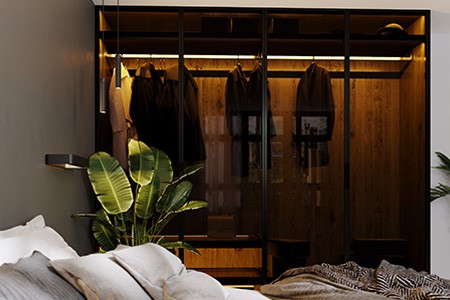
Depending on the size of the bedroom, the closets can range from 24 to 36 inches deep. The depth facilitates the installation of shelving and additional hanging space.
The depth of the bedroom closet can also affect its length. The standard bedroom closets have a length of 48 inches, while larger bedrooms may require a length of up to 96 inches.
The width, however, can range from 24 to 36 inches, depending on how much storage space you need. There's no code that dictates the width here, but don't accept anything less than the standard closet depth no matter the width or it won't make much sense.
Bedroom closets also have other components which make them distinct, including;
- Ample storage space: to provide enough storage space for folded garments, shoes, bags, and other items.
- Adjustable shelves: to offer more space and convenience when reorganizing items.
- Shoe racks: to keep all your shoes in an orderly fashion.
- Hooks: to hang belts, ties, and other accessories.
Bedroom closets also have various designs ranging from traditional reach-in to full walk-ins with adjustable shelving and organization systems. They can also come in different closet colors to allow you to customize the look of the space and make it even feel deeper.
When choosing a bedroom closet, it's necessary to ensure the depth is sufficient for your uses.
Front-Hall Closets
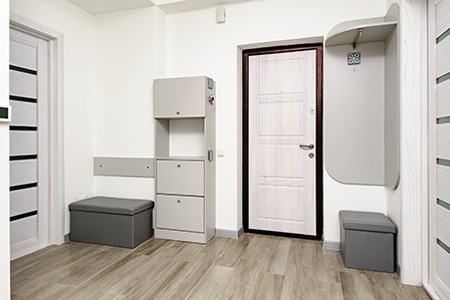
The standard front-hall closet size is usually 24 inches in depth and 48 inches in length. The width of the closet can range from 12 to 24 inches, depending on how much storage space you need.
You can use hallways and entryway closets to store items such as coats, shoes, and umbrellas because of the following characteristics:
- Shallow depth: can allow you to store items without taking up too much space.
- Doors: Various types of closet doors can offer convenient access when entering & leaving the house.
- Adjustable shelves: can provide more space for stacking and organizing things.
- Narrow length & width: can offer quick access to items you may need frequently.
The dimensions and features promote the efficient use of space while maximizing storage capacity. Front-hall closets are especially useful during winter when you need to store outerwear and bulky items.
You can also customize them with adjustable shelves and organization systems. For example, if your interior design includes many accessories, you can use the closet to hang hats, scarves, and other items.
Whichever depth and features you choose for your front-hall closets, ensure that it provides enough storage space for your needs.
Walk-In Closets
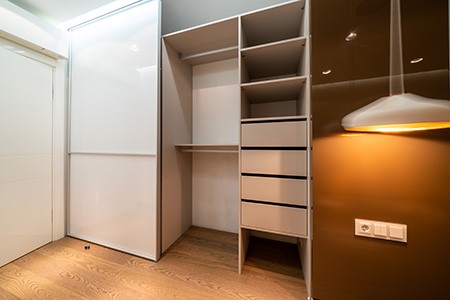
The standard depth for a walk-in closet is between 24 and 36 inches. They are versatile, and their depth is essential for allowing enough room to hang garments and install shelves.
The length ranges from 72 inches to 120 or 144 inches. The width of a walk-in closet varies from 24 to 48 inches.
Each dimension plays a role in the overall storage space of the closet. The standard closet depth here has to take into account not just the square footage or depth, but the width and length as well so you don't have some whacky shape like I've seen in real life.
Walk-in closets can come with adjustable shelving, organization systems, and an array of colors to match your interior design. They can also come with amenities such as mirrors, lights, and drawers to facilitate the storage of items while providing convenience and aesthetics.
These closets are ideal if you need plenty of storage space and want to make your closet a room feature.
Walk-in closets have other features that support their usability in the space, including:
- Cabinet and Shelving Space
- Hanging Bars
- Hooks
- Shoe Racks
Each feature can play a role when designing a walk-in closet. However, you can customize the parts depending on the space size and what you plan to store. You can even install different flooring in the closet rather than letting the carpet from the bedroom continue on.
There are different types of walk-in closets, including:
- Organized closets: Have cabinets, shelves, and drawers to store items in an organized fashion.
- Open concept closets: Have minimal cabinets and shelving for a more relaxed feel.
Whichever type of walk-in closet you opt for, you should consider the depth and size to ensure enough storage space.
Considerations on the Average Depth of a Closet
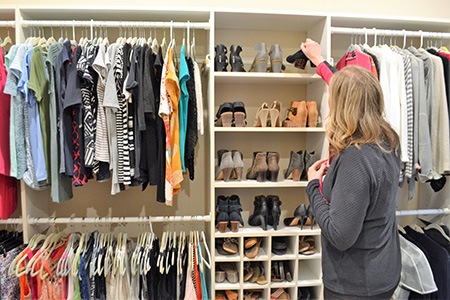
When looking at the depth of closets for your house, there are several things to consider depending on the area you're planning to place it in. The items you're planning to store can also affect the choice of your closet. When getting a closet, consider the following:
- A standard closet size: You should ensure your closet fits the space it's meant for. Many closets have a depth of 24 inches.
- The items you plan to store: If you have bulky items or many clothes, go for a deeper closet. For example, a walk-in closet can be ideal if you plan to store many items, such as coats, shoes, and bulky clothing.
- Types of closets: Depending on the area, there are various options; for example, you can get a reach-in or walk-in closet.
- Bedroom closets: Ensure the depth of your closet is sufficient for your uses.
- Front Hall Closets: Keep in mind the shallow depth and narrow width.
- Walk-In closets: Consider the size and features necessary for your needs.
- Additional features: Shelves, adjustable racks, and hooks may be necessary for your closet. You should choose each element carefully to ensure you get the most out of your closet.
- Your budget: You should also factor in the cost of the closet when deciding.
- Style & closet design: You can customize the design to match your home's interior.
Considering these features, you can choose the correct closet depth that meets all your needs.
FAQ’s Regarding the Standard Closet Depth
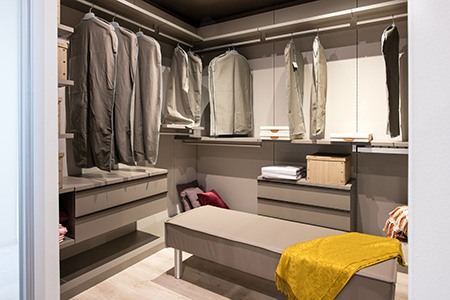
Deciding on the depth and size of a closet can be challenging, especially because the dimensions differ from one closet design to the other. Below are inquiries about the typical depth of a closet that many people make:
What is the Standard Closet Depth?
The standard closet depth varies depending on your closet type. A front-hall closet usually has a depth of 24 inches, while the standard walk-in closet depth is between 24 to 36 inches. You can consider 24 inches the minimum depth for a closet, because they become quite unusable for much below that measurement.
Why is the Depth of a Closet Necessary Design Element?
The depth of the closet is essential for allowing enough room to hang garments and install shelves. It is also crucial for optimizing the amount of storage space you have in your closet.
Are There Any Additional Features to Consider When Choosing a Closet Depth?
Yes, you should also consider additional features such as cabinet and shelving space for storing sweaters, hanging bars, hooks, and shoe racks. The parts can help you maximize storage capacity and customize the closet space.
What is the Standard Bathroom Closet Depth?
The standard bathroom closet depth is usually between 12 and 15 inches on the shallower side. The measurements can maximize the space in a smaller area, for example, if your bedroom has a tiny space. The average depth of a closet is 24 inches, though, in a average-sized bedroom.
By understanding the standard and average closet depth, you can make an informed decision in choosing the right closet size and design for your home. Additionally, you should consider the items you plan to store, your budget, and additional features that support usability. With these tips, you can have an ideal closet space for your home.
The Typical Depth of a Closet is Based on Your Needs & Floorplan
A shallower closet will do the trick if you have more limited space. With careful consideration, you can create the perfect closet for your needs and add a touch of personality to your home.
Now that you know the standard closet depth and size, you can better understand what type of closet will work best for your home. You should opt for a deeper closet with additional features to maximize storage space.



